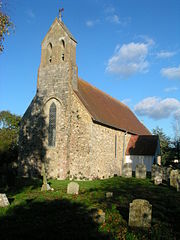Chidham
| Chidham and Hambrook | |
|---|---|
 Chidham church |
|
| Chidham and Hambrook shown within West Sussex | |
| Area | 10.72 km2 (4.14 sq mi) |
| Population | 1,356 2011 Census |
| • Density | 117/km2 (300/sq mi) |
| OS grid reference | SU788038 |
| • London | 57 miles (92 km) NE |
| Civil parish |
|
| District | |
| Shire county | |
| Region | |
| Country | England |
| Sovereign state | United Kingdom |
| Post town | CHICHESTER |
| Postcode district | PO18 |
| Dialling code | 01243 |
| Police | Sussex |
| Fire | West Sussex |
| Ambulance | South East Coast |
| EU Parliament | South East England |
| UK Parliament | |
| Website | http://www.chidhamandhambrook.info/ |
Chidham and Hambrook is a civil parish in the District of Chichester in West Sussex, England located approximately five miles (8 km) west of Chichester, south of the A27 road, near Bosham.Chidham is the ecclesiastical Parish,with a slightly different boundary from that of the civil parish.
A recent excavation has shown that man made use of Chidham more than 4,000 years ago. The flint scrapers discovered on the site on the western shore of the peninsula, seem to suggest that spear shafts or kiddles (fish traps) and primitive salterns were being made here.
The Saxon Saint Cuthman may have been born here, c.681. The village's name is derived from the Old English words ceod (meaning bag or pouch) and ham (meaning settlement), referring to the shape of the peninsula on which it is situated. The present flint and rubble church, St. Mary's, dates from the 13th century, and may have had a wooden predecessor. The peninsula is not mentioned in the Domesday Book because it was part of the Manor or Chapelry of Bosham, rich in farming land and then belonging to the Bishop of Exeter.
Close to the church of St. Mary is the manor house, a large late 17th century building. The manor house has had recent work done with permission from the council.
Facing the church, on its south side, is a large early 19th century vicarage known as the 'Old Rectory', now a private house.
The men of Chidham seem to have been farmers rather than fishermen or sailors, probably due to the good quality of the soil.
In 1812 an embankment wall was built from Chidham to Bosham, where use was made of an old quay. Writing of Bosham in the 1860s Charles Longcroft described how the newly enclosed land was ploughed and planted with corn. 'But one November, there came a raging tide and a gale wind, from the southwest and away went the embankment..'. In 1825 the sea returned covering the farmland and inundating new buildings. One of these is said to have been a mansion, standing at Cutmill whose stone was afterwards used to build Cutmill Cottage.
...
Wikipedia

